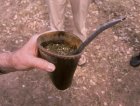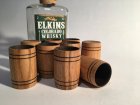On a recent trip around South America, I became intrigued by a beverage popular down there called Mate. Mate, for those who don't know, (I didn't) is a kind of tea made from the leaves and stems of a tree, steeped in hot - not boiling - water in a "mate cup". The tea is drunk through a "bombilla", a stainless steel straw with a filter in it to remove the vegetable material. Mate cups, down there, are most often made of gourds, but also of wood, ceramic or glass. I've read that mate cups made of gourd or wood have no finish inside and need to be "seasoned". One puts the herb in the cup, adds hot water, and lets it sit for 24 hr. I want to turn 4 of these cups and give 3 away to my traveling companions.
My question: Is there a finish that could be used on the INSIDE of such a cup that would withstand the hot water and not give a flavor - or poison the drinker?
Thanks,
Russ
My question: Is there a finish that could be used on the INSIDE of such a cup that would withstand the hot water and not give a flavor - or poison the drinker?
Thanks,
Russ


